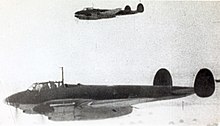Pavel Andreyevich Galkin
Following the outbreak of war he studied at the Nikolaev Naval Aviation School, graduating in July 1943, as a crew navigator and was sent to the front lines.
Though retired from active service, Galkin maintained his connection with the armed forces, working as head of the educational and methodological office at the Yeysk Higher Military Aviation School between 1982 and 1996.
[1] His father had been a sailor of the Baltic Fleet and a member of the Kronstadt Military Revolutionary Council, who took part in many of the events of the Russian Revolution in Petrograd.
[2] A firm believer in communism, who had seen Vladimir Lenin give his speech from his armoured car, he had returned to his home town on holiday in 1921, but stayed to build Soviet power.
[2] He served on the Road of Life during the siege of Leningrad in the Second World War and was wounded, later dying at the 1st Naval Hospital, and being buried at the Piskarevskoye Cemetery.
[3] He declined to talk about the third time, but concluded that he was not destined to die by water, later carrying a handkerchief embroidered by his mother in his pocket as a talisman when he flew in action.
[2][4] He joined the Soviet Navy in September that year, and was initially posted to Leningrad as an anti-aircraft battery gunner with the coastal defence forces.
[2][4] By now a guards lieutenant, from around October 1943 Galkin was part of the aircraft crew of Yevgeny Frantsev [ru], the commander, and Semyon Antipichev, the gunner-radio operator.
[1][4] On 5 April 1944 the acting commander of the 9th Guards Torpedo Aviation Regiment, Major Litvinov, nominated Galkin for the title of Hero of the Soviet Union.
[1] In 1967 he became head of the department of combat weapons at the Yeysk Higher Military Aviation School [ru], a post he held until his retirement in May 1978 with the rank of colonel.
[6] Though retired from active service, Galkin maintained his connection with the armed forces, working as head of the educational and methodological office at the Yeysk Higher Military Aviation School between 1982 and 1996.
[1][4] At the time of his death he was the last member of the Yeysk veterans' council, which in 1990 had consisted of 126 Heroes of the Soviet Union, and 27 holders of the Order of Glory First Class.



